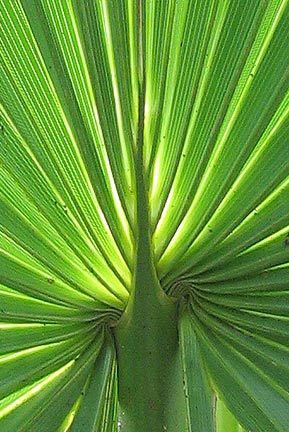|
by Bob Harms ( |
| S. mexicana | S. minor |
| (Scale in millimeters) | |
The inflorescence of the Dwarf Palmetto rises above the leaves, later arcing down under the weight of fruits as seen below (right); that of S. mexicana always remains within the leaves. The stem and leaves of S. mexicana are frequently several times larger than those of S. minor.The Clark Field S. mexicana plants below (left), though larger than those on the right, will not bloom for many years.
| Clark Field S. mexicana plants | S. minor infructescence |
One key indicator of Texas Palmetto is the presence of a visible, emerged trunk, clearly present among the seminary area palms and 8 of the campus plants. But the slow growing S. mexicana does not develop a trunk for many years – even with leaves as tall as 12 feet, and most of the Waller plants are simply too young for this feature to be useful. Strictly speaking, merely to note the presence or absence of a trunk (as on the summary table) is somewhat misleading. Even Dwarf Palmettos have a trunk – but it remains below ground – one of the main reasons that it is virtually impossible to move larger plants from a natural site.
With the Waller palmettos the form of the leaf alone suffices to rule out the presence of Dwarf Palmettos. Once a leaf has developed to the point that it has several segments, the distinction will be clear. Seedlings and very small one-leaf plants can't always be safely distinguished, but these represented only a tiny portion of the total population surveyed. The leaf of the Texas Palmetto has a central rib (costa) that runs almost the length of the leaf; the S. minor leaf has only a very short rib, and generally has instead a very deep central cleft. This rib, which is an extension of the leaf stalk (petiole), is best viewed on the lower (abaxial) side of the leaf. With a strongly costapalmate leaf, the leaf segments emerge pretty much along its full length. [For a discussion of palmate, costapalmate, and a related term, hastula.]
 |
|
| Waller S. mexicana strongly costapalmate leaf | S. minor weakly costapalmate leaf |
Note that the segments of S. mexicana radiate along the full length of the central rib (strongly costapalmate) whereas the segments of S. minor are almost entirely at the leaf base (weakly costapalmate), and the rib itself is much shorter relative to the leaf segments.
Even with quite young plants the difference in leaf structure is clear. Note also the difference in stem (petiole) length.
| Waller S. mexicana 4-inch section of 2-foot leaf |
Waller S. mexicana young plants |
typical young S. minor leaves |
A final note on the common confusion of these two species is in order. Without careful attention to detail, the trunkless Clark Field plants at the top of the page might easily be mistaken for Dwarf Palmettos. One need look no further than the Zilker Park Garden Center to find 'Sabal minor' identification plates associated with both Texas Palmetto and a third distinct arborescent native palmetto, the Brazoria Palmetto (Sabal × brazoriensis).